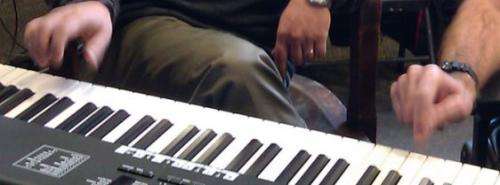August 12, 2014 report
Physicist develops stochastic model to describe interbeat variation patterns between musicians

(Phys.org) —Physicist Holger Hennig, currently with OptWare in Munich, Germany, has developed a stochastic model to describe synchronization that occurs in human musical rhythms that involve more than one person. In his paper published in Proceedings of the National Academy of Sciences, Henning describes how he discovered that when two musicians are playing together, a beat played by one person can depend on up to several minutes of the other person's prior interbeat intervals—the model he developed can be used, he claims, to produce more natural sounding computer generated music.
Most people can tell when the music they are listening to is backed by computer generated sounds, whether percussion, stringed instruments or even other beat setting implements—it just sounds too "perfect" to the human ear. For that reason, scientists have been searching for ways to introduce less perfection, to fool the listener into believing they are listening to music created exclusively by humans (because most people prefer it that way). Intrigued by such work, Henning set up some experiments of his own. He had pairs of musicians play together on keyboards—some were professional, some were not. In analyzing the music produced by the musicians, Henning noted that no matter the skill level, no human player can keep a perfect beat going.
Because of this, when two or more people play together, there must be some means of adjustment or the music will become unsynchronized. But it's not as simple as a simply picking up the beat if a partner does, or slowing when need be. He found that for any given beat of music, both musicians rely on interbeat intervals to decide when to proceed. This he found is because as two musicians play together, they develop interval patterns, and the patterns develop due to inconsistencies that develop throughout play. A single speedup or slowdown, near the beginning of a piece, for example, can be adjusted for later on, by both players—sometimes over and over again. It's all these inconsistencies that make up the pattern that the two musicians develop together.
What's more, the patterns are predictable to such an extent that Henning was able to build a stochastic model to describe them—a model that can be used to introduce human error into computer generated music to make it sound more human. He notes that the same model might also be applicable to other complex systems that involve interaction.
More information: Synchronization in human musical rhythms and mutually interacting complex systems, Holger Hennig, PNAS, DOI: 10.1073/pnas.1324142111
Abstract
Though the music produced by an ensemble is influenced by multiple factors, including musical genre, musician skill, and individual interpretation, rhythmic synchronization is at the foundation of musical interaction. Here, we study the statistical nature of the mutual interaction between two humans synchronizing rhythms. We find that the interbeat intervals of both laypeople and professional musicians exhibit scale-free (power law) cross-correlations. Surprisingly, the next beat to be played by one person is dependent on the entire history of the other person's interbeat intervals on timescales up to several minutes. To understand this finding, we propose a general stochastic model for mutually interacting complex systems, which suggests a physiologically motivated explanation for the occurrence of scale-free cross-correlations. We show that the observed long-term memory phenomenon in rhythmic synchronization can be imitated by fractal coupling of separately recorded or synthesized audio tracks and thus applied in electronic music. Though this study provides an understanding of fundamental characteristics of timing and synchronization at the interbrain level, the mutually interacting complex systems model may also be applied to study the dynamics of other complex systems where scale-free cross-correlations have been observed, including econophysics, physiological time series, and collective behavior of animal flocks.
Journal information: Proceedings of the National Academy of Sciences
© 2014 Phys.org



















